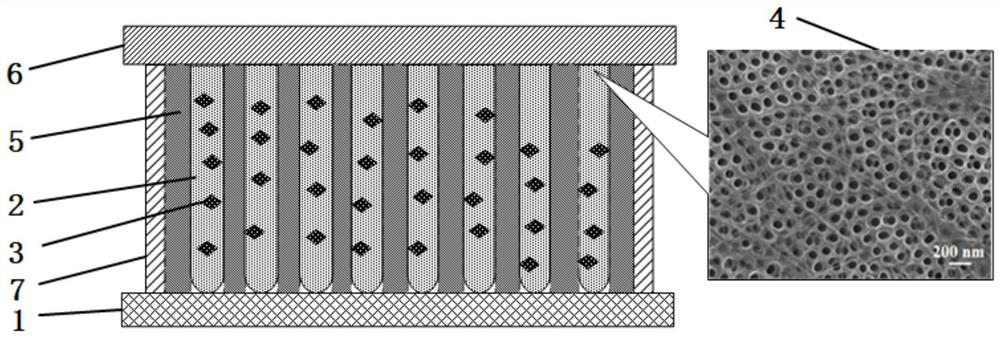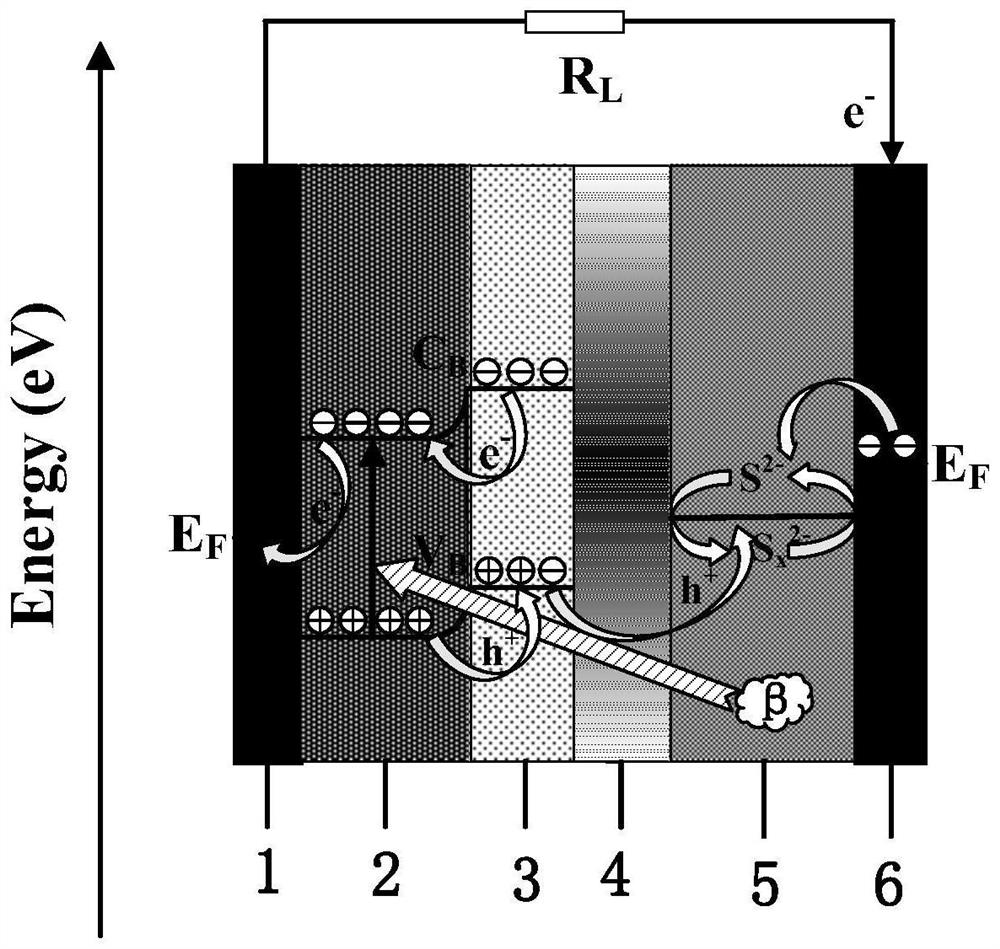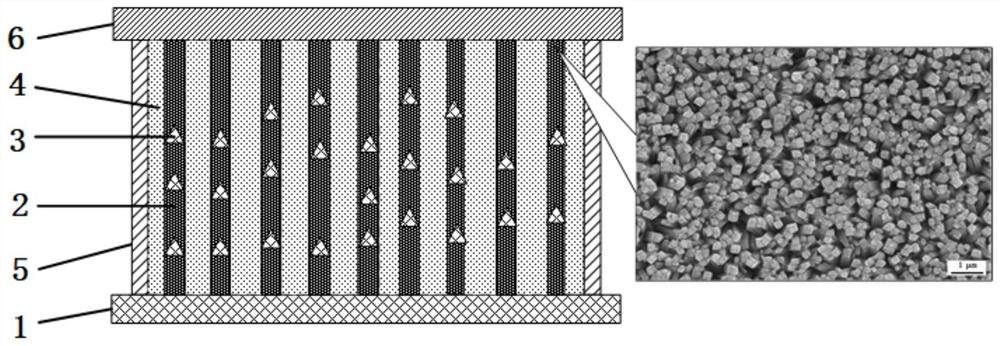Radiovolt electrochemical radioisotope battery
A radioisotope, electrochemical technology, applied in the field of radiovoltaic electrochemical radioisotope batteries, can solve the problems of low energy conversion efficiency, low energy conversion efficiency of isotope batteries, small specific surface area of radiation sources, etc.
- Summary
- Abstract
- Description
- Claims
- Application Information
AI Technical Summary
Problems solved by technology
Method used
Image
Examples
Embodiment 1
[0050] figure 1 is based on S x 2- / S 2- Schematic diagram of the structure of a radiative electrochemical cell with redox pairs and a liquid electrolyte titanium dioxide nanotube array compounded with cadmium sulfide and single-walled carbon nanotubes, as shown in figure 1 As shown, this embodiment includes 1-titanium metal substrate electrode, 2-titanium dioxide nanotube array, 3-cadmium sulfide quantum dot, 4-single-walled carbon nanotube, 5-tritium water and liquid electrolyte, 6-ITO cathode, 7-Seal chamber.
[0051] In this embodiment, the titanium dioxide nanotube array film is made of a plurality of parallel TiO 2 Nanotubes and titanium metal substrate electrodes are stacked vertically side by side; the liquid electrolyte and liquid isotope radiation source are integrated in the three-dimensional nanospace of the nanotube array; the cathode material is ITO conductive glass (surface resistance 8Ω / cm 2 ); the isotope radiation source is tritium water, and the liquid ...
Embodiment 2
[0060] image 3 based on I 3 - / I - Schematic diagram of the structure of the radiative electrochemical cell with redox pair and quasi-solid electrolyte titanium dioxide nanorod array structure, as shown in image 3 As shown, this embodiment includes 1-FTO substrate electrode, 2-titanium dioxide nanorod array, 3-Pt nanoparticles, 4-radioactive quasi-solid electrolyte, 5-sealed cavity, 6-Pt cathode.
[0061] In this embodiment, the titanium dioxide nanorod array film is formed by arranging highly ordered square nanorods; the radioactive quasi-solid-state electrolyte will have radioactive 14 C nanoparticles are added to the organic solvent of sodium iodide and iodine to solidify, and then integrated in the three-dimensional nanospace of the nanorod array; the cathode material is a Pt electrode, and the substrate electrode is FTO conductive glass (surface resistance 8Ω / cm 2 ).
[0062] The preparation method of the radiant electrochemical cell described in this embodiment co...
Embodiment 3
[0069] Figure 5 Schematic diagram of the structure of a radiative electrochemical cell based on a zinc oxide nanorod array composite nickel oxide structure based on a solid electrolyte, as shown in Figure 5 As shown, this embodiment includes 1-AZO substrate electrode, 2-zinc oxide nanowire array, 3-radioactive solid electrolyte 63 NiO, 4-nickel cathode, 5-sealed cavity.
[0070] In this embodiment, the zinc oxide nanowire array film is formed by stacking highly ordered and neatly arranged hexagonal nanowires; the radioactive solid electrolyte refers to the P-type semiconductor used as the hole transport layer 63 NiO nanoflowers, which cover the surface of the zinc oxide nanowire array film; the cathode material is a nickel metal electrode, and the substrate electrode is AZO conductive glass (surface square resistance 8Ω / cm 2 ).
[0071] The preparation method of the radiant electrochemical cell described in this embodiment comprises the following steps:
[0072] (1) Prep...
PUM
| Property | Measurement | Unit |
|---|---|---|
| Diameter | aaaaa | aaaaa |
| Diameter length | aaaaa | aaaaa |
Abstract
Description
Claims
Application Information
 Login to View More
Login to View More - R&D
- Intellectual Property
- Life Sciences
- Materials
- Tech Scout
- Unparalleled Data Quality
- Higher Quality Content
- 60% Fewer Hallucinations
Browse by: Latest US Patents, China's latest patents, Technical Efficacy Thesaurus, Application Domain, Technology Topic, Popular Technical Reports.
© 2025 PatSnap. All rights reserved.Legal|Privacy policy|Modern Slavery Act Transparency Statement|Sitemap|About US| Contact US: help@patsnap.com



